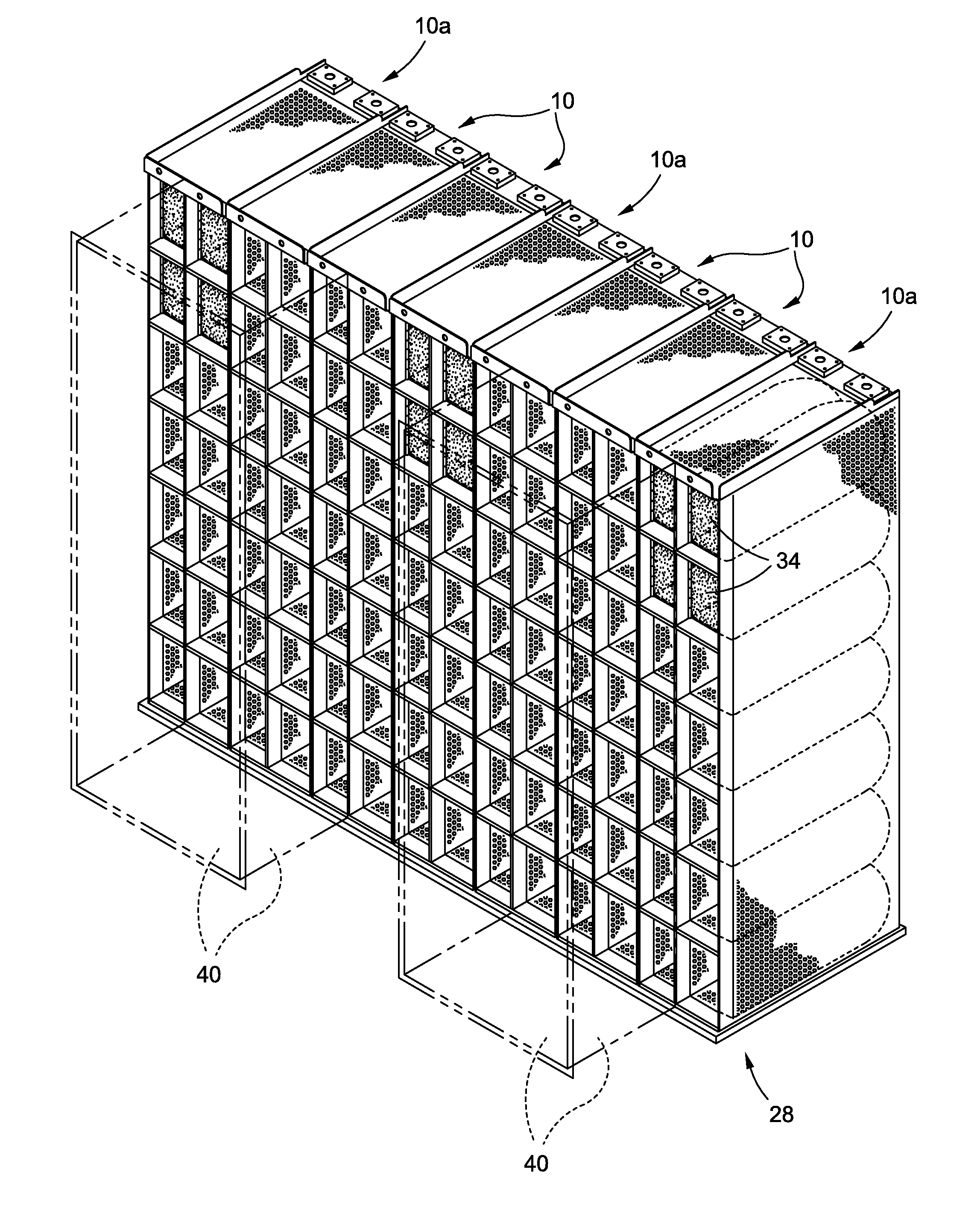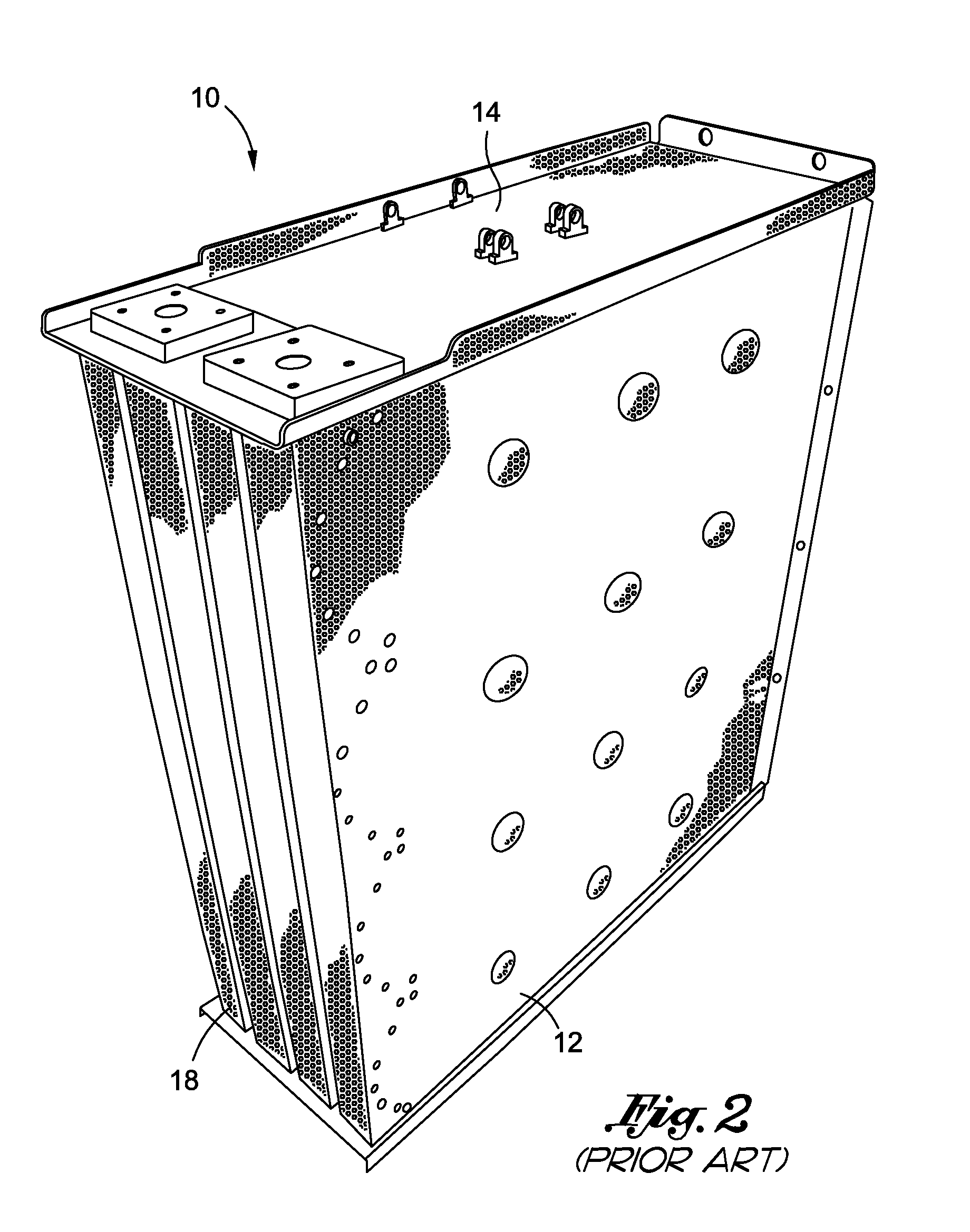Increased efficiency strainer system
a strainer and efficiency technology, applied in the direction of separation processes, nuclear elements, greenhouse gas reduction, etc., can solve the problems of damage to the emergency core cooling system pump, increased labor, and headache, so as to reduce the required strainer surface area, reduce the maximum differential pressure experienced, and reduce the effect of head loss
- Summary
- Abstract
- Description
- Claims
- Application Information
AI Technical Summary
Benefits of technology
Problems solved by technology
Method used
Image
Examples
second embodiment
[0044]Referring now to FIGS. 6-8, there is shown a strainer module 100 constructed in accordance with the present invention. The strainer module 100 comprises a generally cylindrical, tubular main body section 102 which defines a section plenum 104 extending axially therethrough. Extending radially from the outer surface of the main body section 102 in spaced, generally parallel relation to each other are a plurality of circularly configured separator plates 106. Though not shown in FIG. 6, the main body section 102 includes openings formed therein which allow liquid flowing between the separator plates 106 to be drawn into the suction plenum 104 via such openings upon the creation of a pressure differential condition attributable to the activation of a pump fluidly coupled to the suction plenum 104.
[0045]The strainer module 100 further comprises at least one circularly configured strainer cartridge 108 which is positioned between a prescribed adjacent pair of the separator plates 1...
third embodiment
[0049]Referring now to FIG. 9, there is shown a strainer module 200 constructed in accordance with the present invention. The sole distinction between the strainer modules 100, 200 lies in the separator plates 206 included in the strainer module 200 each having a generally quadrangular (e.g. square) configuration, as opposed to the circular configuration of the above-described separator plates 106 included in the strainer module 100.
fourth embodiment
[0050]Referring now to FIGS. 10 and 11, there is shown a strainer module 300 constructed in accordance with the present invention. The strainer module 400 comprises a main body section 402 which has a generally quadrangular cross-sectional configuration and defines a suction plenum 404. Attached to a common wall of the main body section 402 and protruding therefrom in spaced, generally parallel relation to each other are a plurality of (e.g., four) cylindrically configured, tubular primary strainer elements 406 which each fluidly communicate with the suction plenum 404. Each of the primary strainer elements 406 defines an inflow end 408, and comprises concentrically positioned outer and inner walls 410, 412. The outer and inner walls 410, 412 are each fabricated from a perforated metal, mesh-like material. The inflow end 408 is typically defined solely by the inner wall 412 of the primary strainer element 406.
[0051]In the exemplary strainer module 400, the inflow end 408 of one of t...
PUM
| Property | Measurement | Unit |
|---|---|---|
| pressure | aaaaa | aaaaa |
| elastic | aaaaa | aaaaa |
| head loss | aaaaa | aaaaa |
Abstract
Description
Claims
Application Information
 Login to View More
Login to View More - R&D
- Intellectual Property
- Life Sciences
- Materials
- Tech Scout
- Unparalleled Data Quality
- Higher Quality Content
- 60% Fewer Hallucinations
Browse by: Latest US Patents, China's latest patents, Technical Efficacy Thesaurus, Application Domain, Technology Topic, Popular Technical Reports.
© 2025 PatSnap. All rights reserved.Legal|Privacy policy|Modern Slavery Act Transparency Statement|Sitemap|About US| Contact US: help@patsnap.com



